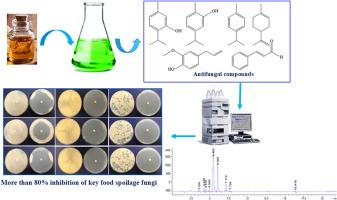Development of antifungal formulations using silver nanoparticles and natural antimicrobials for food preservation
IF 3.5
3区 医学
Q3 IMMUNOLOGY
引用次数: 0
Abstract
This study aimed to evaluate natural antifungal agents for controlling food spoilage caused by Botrytis cinerea, Rhizopus stolonifer, and Alternaria brassicae. Various plant-derived essential oils (EOs), including Mediterranean, Pan Tropical, Greek, Canada pine, Nepal pine, clove bud, cumin, Moroccan, and others, as well as 2 citrus extracts, and spherical silver nanoparticles (AgNPs: AGPPH and AGC 0.5) were tested for their antifungal properties. A broth microdilution assay was employed to determine the minimum inhibitory concentrations (MICs) of individual EOs and AgNPs. The potential interactions between EOs and AgNPs were evaluated using the checkerboard method by calculating fractional inhibitory concentration (FIC) indices. The chemical compositions of selected EOs (Mediterranean, Greece, Pan Tropical, and Morocco) were analyzed using high-performance liquid chromatography (HPLC), revealing that over 97 % of their content comprised 15 major components, including trans-cinnamaldehyde, trans-p-methoxy cinnamaldehyde, trans-o-methoxy cinnamaldehyde, cis-cinnamaldehyde, cinnamyl acetate, coumarin, thymol, carvacrol, p-cymene, γ-terpinene, linalool, β-caryophyllene, α-pinene, myrcene and α-terpinene. Based on MIC and FIC results, three active formulations (AFs) were developed: AF1 (Mediterranean EO/Greece EO/Pan Tropical EO/AGC 0.5, 0.3:0.3:2.5:0.05), AF2 (Morocco EO/Greece EO/Pan Tropical EO/AGPPH, 0.3:0.3:2.5:0.05), and AF3 (Morocco EO/Mediterranean EO/Pan Tropical EO/AGC 0.5, 0.3:0.3:2.5:0.05). Their antifungal efficacy was assessed through MIC and agar diffusion assays. The formulations demonstrated strong antifungal activity, inhibiting R. stolonifer (80.7–89.0 %), B. cinerea (96.3–100 %), and A. brassicae (94.3–100 %). These findings suggest that these EO/AgNP-based formulations could serve as effective green antifungal agents for food preservation.

利用银纳米粒子和天然抗菌剂进行食品保鲜的抗真菌制剂的开发。
本研究旨在评价天然抗真菌剂对灰霉病菌、匍匐茎霉和十字花科互花霉引起的食品腐败的防治效果。各种植物衍生精油(EOs),包括地中海、泛热带、希腊、加拿大松、尼泊尔松、丁香芽、孜然、摩洛哥等,以及2种柑橘提取物,以及球形纳米银(AgNPs: AGPPH和AGC 0.5)的抗真菌性能进行了测试。采用肉汤微量稀释法测定单个EOs和AgNPs的最低抑制浓度(mic)。通过计算分数抑制浓度(FIC)指数,采用棋盘法评估EOs和AgNPs之间的潜在相互作用。采用高效液相色谱法(HPLC)对地中海、希腊、泛热带和摩洛哥4个产地的精油进行化学成分分析,发现其97%以上的主要成分为反式肉桂醛、反式对甲氧基肉桂醛、反式对甲氧基肉桂醛、顺式肉桂醛、肉桂乙酸酯、香豆素、百里酚、香芹醇、对伞花烃、γ-萜烯、芳樟醇、β-石竹烯、α-蒎烯、月桂烯和α-萜烯等15种主要成分。根据MIC和FIC结果,开发出3种活性配方:AF1(地中海EO/希腊EO/泛热带EO/AGC 0.5, 0.3:0.3:2.5:0.05)、AF2(摩洛哥EO/希腊EO/泛热带EO/AGPPH, 0.3:0.3:2.5:0.05)和AF3(摩洛哥EO/地中海EO/泛热带EO/AGC 0.5, 0.3:0.3:2.5:0.05)。通过MIC和琼脂扩散试验评估其抗真菌效果。对匍匐茎霉(80.7 ~ 89.0%)、灰霉病芽孢杆菌(96.3 ~ 100%)、十字花科芽孢杆菌(94.3 ~ 100%)具有较强的抑菌活性。这些结果表明,这些基于EO/ agnp的配方可以作为有效的绿色抗真菌剂用于食品保鲜。
本文章由计算机程序翻译,如有差异,请以英文原文为准。
求助全文
约1分钟内获得全文
求助全文
来源期刊

Microbial pathogenesis
医学-免疫学
CiteScore
7.40
自引率
2.60%
发文量
472
审稿时长
56 days
期刊介绍:
Microbial Pathogenesis publishes original contributions and reviews about the molecular and cellular mechanisms of infectious diseases. It covers microbiology, host-pathogen interaction and immunology related to infectious agents, including bacteria, fungi, viruses and protozoa. It also accepts papers in the field of clinical microbiology, with the exception of case reports.
Research Areas Include:
-Pathogenesis
-Virulence factors
-Host susceptibility or resistance
-Immune mechanisms
-Identification, cloning and sequencing of relevant genes
-Genetic studies
-Viruses, prokaryotic organisms and protozoa
-Microbiota
-Systems biology related to infectious diseases
-Targets for vaccine design (pre-clinical studies)
 求助内容:
求助内容: 应助结果提醒方式:
应助结果提醒方式:


